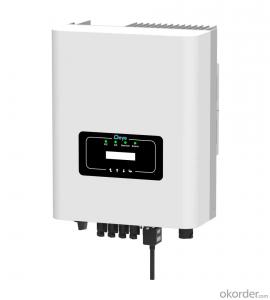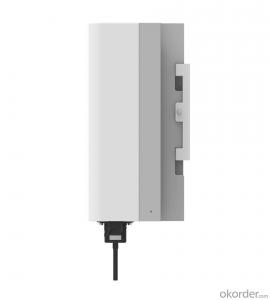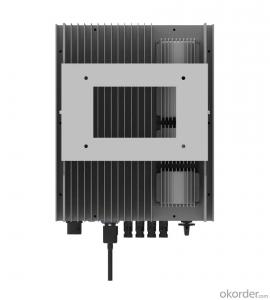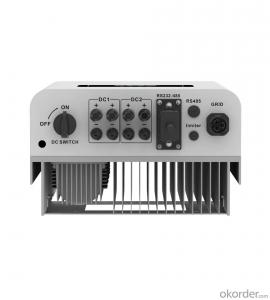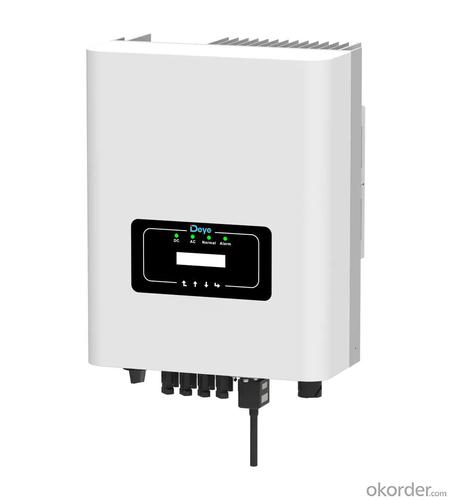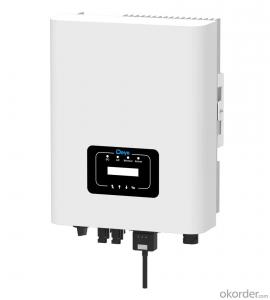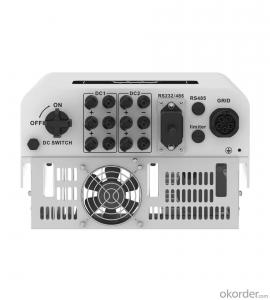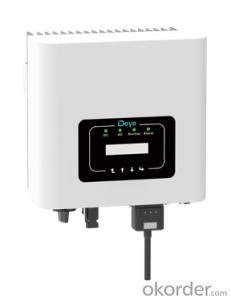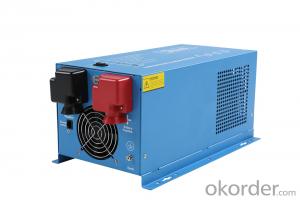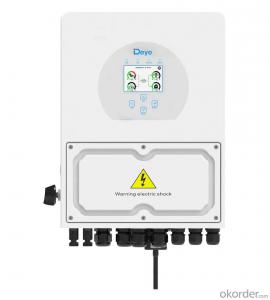200KW Solar Inverter - Sun-7/7.5/8/9/10/10.5k-g | 7-10.5kW | Single Phase | 2 MPPT
- Loading Port:
- Ningbo
- Payment Terms:
- TT OR LC
- Min Order Qty:
- 100 pc
- Supply Capability:
- 5000 pc/month
OKorder Service Pledge
OKorder Financial Service
You Might Also Like
Specification
| Model | SUN-7K-G | SUN-7.5K-G | SUN-8K-G | SUN-9K-G | SUN-10K-G | SUN-10.5K-G | |
| Input Side | |||||||
| Max. DC Input Power (kW) | 9.1 | 9.8 | 10.4 | 11.7 | 13 | 13.7 | |
| Max. DC Input Voltage (V) | 550 | ||||||
| Start-up DC Input Voltage (V) | 80 | ||||||
| MPPT Operating Range (V) | 70~500 | ||||||
| Max. DC Input Current (A) | 13+26 | 26+26 | |||||
| Max. Short Circuit Current (A) | 19.5+39 | 39+39 | |||||
| Number of MPPT / Strings per MPPT | 2/1+2 | 2/2 | |||||
| Output Side | |||||||
| Rated Output Power (kW) | 7 | 7.5 | 8 | 9 | 10 | 10.5 | |
| Max. Active Power (kW) | 7.7 | 8.25 | 8.8 | 9.9 | 11 | 11.55 | |
| Nominal Output Voltage / Range (V) | L/N/PE 220V/0.85Un-1.1Un, 230V/0.85Un-1.1Un (Optional) | ||||||
| Rated Grid Frequency (Hz) | 50 / 60 (Optional) | ||||||
| Operating Phase | Single phase | ||||||
| Rated AC Grid Output Current (A) | 30.4 | 32.6 | 34.8 | 39.1 | 43.5 | 45.7 | |
| Max. AC Output Current (A) | 33.5 | 35.9 | 38.3 | 43 | 47.8 | 50.2 | |
| Output Power Factor | 0.8 leading to 0.8 lagging | ||||||
| Grid Current THD | <3% | ||||||
| DC Injection Current (mA) | <0.5% | ||||||
| Grid Frequency Range | 47~52 or 57~62 (Optional) | ||||||
| Efficiency | |||||||
| Max. Efficiency | 97.7% | ||||||
| Euro Efficiency | 97.5% | ||||||
| MPPT Efficiency | >99% | ||||||
| Protection | |||||||
| DC Reverse-Polarity Protection | Yes | ||||||
| AC Short Circuit Protection | Yes | ||||||
| AC Output Overcurrent Protection | Yes | ||||||
| Output Overvoltage Protection | Yes | ||||||
| Insulation Resistance Protection | Yes | ||||||
| Ground Fault Monitoring | Yes | ||||||
| Anti-islanding Protection | Yes | ||||||
| Temperature Protection | Yes | ||||||
| Integrated DC Switch | Yes | ||||||
| Remote software upload | Yes | ||||||
| Remote change of operating parameters | Yes | ||||||
| Surge protection | DC Type II / AC Type II | ||||||
| General Data | |||||||
| Size (mm) | 330W×410H×198.5D | ||||||
| Weight (kg) | 15.7 | ||||||
| Topology | Transformerless | ||||||
| Internal Consumption | <1W (Night) | ||||||
| Running Temperature | -25~65℃, >45℃ derating | ||||||
| Ingress Protection | IP65 | ||||||
| Noise Emission (Typical) | <25 dB | ||||||
| Cooling Concept | Natural cooling | ||||||
| Max. Operating Altitude Without Derating | 2000m | ||||||
| Warranty | 5 years | ||||||
| Grid Connection Standard | CEI 0-21, VDE-AR-N 4105, NRS 097, IEC 62116, IEC 61727, G99, G98, VDE 0126-1-1, RD 1699, C10-11 | ||||||
| Operating Surroundings Humidity | 0-100% | ||||||
| Safety EMC / Standard | IEC/EN 61000-6-1/2/3/4, IEC/EN 62109-1, IEC/EN 62109-2 | ||||||
| Features | |||||||
| DC Connection | MC-4 mateable | ||||||
| AC Connection | IP65 rated plug | ||||||
| Display | LCD1602 | ||||||
| Interface | RS485/RS232/Wifi/LAN | ||||||
· 2 MPP trackers, Max. efficiency up to 97.7%
· Zero export application, VSG application
· String intelligent monitoring (optional)
· Wide output voltage range
· Anti-PID function (Optional)
The single-phase inverter is one of the best options for residential application thanks to its smaller size and local LCD display, buttons. Also, with built-in zero-export function (external CT is needed), it offers true ease and comfort for PV system operators and installers.
- Q: Can a solar inverter be used with bifacial solar panels?
- Yes, a solar inverter can be used with bifacial solar panels. Bifacial solar panels can generate electricity from both sides, capturing sunlight from both the front and back surfaces. The solar inverter is responsible for converting the DC power generated by the solar panels into AC power that can be used in homes or fed into the grid. Therefore, a solar inverter is an essential component for any solar panel system, including those with bifacial panels.
- Q: What is the maximum power rating of a solar inverter?
- The maximum power rating of a solar inverter typically depends on its size and capacity, but it can range from a few hundred watts to several megawatts.
- Q: What is the maximum DC input current of a solar inverter?
- The maximum DC input current of a solar inverter depends on its specifications and design. It can vary greatly depending on the model and capacity of the inverter. It is essential to refer to the manufacturer's documentation or specifications to determine the specific maximum DC input current for a particular solar inverter.
- Q: What is the cost of a solar inverter?
- The cost of a solar inverter can vary depending on various factors such as the brand, size, capacity, and additional features. Generally, residential solar inverters can range from $500 to $2,000, while commercial or larger-scale inverters can cost several thousand dollars. It is recommended to consult with a solar installer or supplier to get an accurate cost estimate based on your specific requirements.
- Q: What is the role of reactive power control in a solar inverter?
- The role of reactive power control in a solar inverter is to manage and regulate the flow of reactive power in the electrical system. It helps to maintain a stable voltage level, improve power factor, and ensure efficient operation of the solar inverter. By controlling reactive power, the inverter can mitigate voltage fluctuations and provide optimal power quality, making the system more reliable and compliant with grid requirements.
- Q: Can a solar inverter be used in a solar-powered street lighting system?
- Yes, a solar inverter can be used in a solar-powered street lighting system. The solar inverter is responsible for converting the direct current (DC) power generated by the solar panels into alternating current (AC) power, which is required for the operation of street lights. Therefore, it plays a crucial role in ensuring the efficient and reliable functioning of a solar-powered street lighting system.
- Q: Can a solar inverter be used with solar-powered water heaters?
- No, a solar inverter cannot be directly used with solar-powered water heaters as they serve different purposes. A solar inverter is used to convert the direct current (DC) electricity produced by solar panels into alternating current (AC) electricity for use in homes or businesses. On the other hand, solar-powered water heaters utilize the sun's energy to heat water directly, without the need for electricity conversion.
- Q: What is the maximum number of solar panels that a solar inverter can support?
- The maximum number of solar panels that a solar inverter can support depends on the capacity and specifications of the specific inverter model. There is no universal limit, as different inverters have different capabilities, but typically, a solar inverter can support anywhere from a few panels to several hundred panels. It is important to consult the manufacturer's guidelines and technical specifications to determine the maximum number of panels that a particular solar inverter can handle.
- Q: What are the key features to consider when choosing a solar inverter?
- When choosing a solar inverter, there are several key features to consider. Firstly, the power rating or capacity of the inverter should match the size of your solar panel system to ensure efficient energy conversion. Additionally, the efficiency rating of the inverter is important as it determines how much energy is lost during the conversion process. It is also crucial to look for an inverter with reliable and durable components to ensure long-term performance and minimize maintenance costs. Other important features include the presence of monitoring capabilities, such as data logging and remote monitoring, which allow you to track the performance of your solar system. Finally, considering the warranty and customer support offered by the manufacturer is essential to ensure adequate support and protection for your investment.
- Q: What is the difference between a single-phase and three-phase solar inverter?
- A single-phase solar inverter is designed to convert the direct current (DC) produced by a solar panel into alternating current (AC) for use in single-phase electrical systems. It is typically used in residential or small-scale solar installations. On the other hand, a three-phase solar inverter is capable of converting DC power into AC power for use in three-phase electrical systems, which are commonly found in commercial or industrial settings. The main difference lies in the number of phases supported and the scale of the electrical system they are designed for.
Send your message to us
200KW Solar Inverter - Sun-7/7.5/8/9/10/10.5k-g | 7-10.5kW | Single Phase | 2 MPPT
- Loading Port:
- Ningbo
- Payment Terms:
- TT OR LC
- Min Order Qty:
- 100 pc
- Supply Capability:
- 5000 pc/month
OKorder Service Pledge
OKorder Financial Service
Similar products
Hot products
Hot Searches
Related keywords
